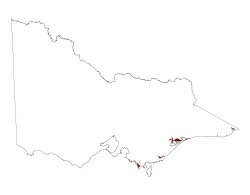7.3.2 Plains with dunes (Woodside, Longford, Munro plains with dunes)
7. Eastern Plains (EP)
7.3 High level terraces and fans
| Most of the plains within this unit are similar to the plains described under 7.3.1 “Plains”. The discontinuous sand dunes that partly mantle these plains have an overall west-east trend. It is likely the sand on the Woodside and Longford plains originated from the Tertiary Neogene sandstones of the Southern Uplands, and was successively mobilized from the west during the dry, cold and windy conditions associated with past glacial periods. The soils on the plains are generally sodic texture contrast soils (Sodosols), with the dunes being comprised of leached acidic sands, usually with a B horizon of iron cemented sand (Podosols). Extensive areas of plains with dunes mostly occur east of Blackall Creek north of Stratford and east of the Perry River between Stratford and Bairnsdale. These sand hills and dunes form a discontinuous mantle over the plains and become more extensive east of Perry River. The sand dunes were most likely formed from sands blown from these streams by the prevailing westerly winds, particularly during periods of aridity associated with past glacial periods. The soils on the plains are similar to those on the older alluvial plains and terraces to the west, (Sodosols), with the soils on the dunes being deep, highly acidic sands, often with “coffee rock” in the subsoil (Podosols). Clays underlie these sands at a variable depth, except around Bengworden. Most of the original vegetation is now cleared for grazing, but some remnants of the former plains grassy woodland remain on the plains with areas of heathy woodland on the dunes. |  |


